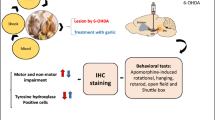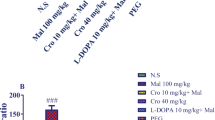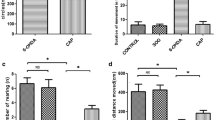Abstract
Parkinson’s disease is caused by damage to substantia nigra dopaminergic neurons. Factors such as oxidative stress, inflammatory factors, and acetylcholinesterase activity may induce this disease. On the other hand, crocin—one of the active ingredients of saffron—has anti-oxidant and anti-inflammatory properties. This study was performed to evaluate the protective effect of crocin to decrease dopaminergic neuron damage and Parkinson’s disease complications induced by 1-methyl-4-phenyl-1,2,3,6-tetrahydropyridine (MPTP). A set of 24 male BALB/c Mice were divided randomly into four groups: (1) MPTP group receiving 30 mg/kg MPTP for 5 days; (2) MPTP + crocin group receiving 30 mg/kg MPTP for 5 days and 30 mg/kg crocin for 15 days; (3) NS group receiving normal saline for 5 days; and (4) NSIG group receiving normal saline intraperitoneally for 5 days and also normal saline by gavage for 15 days. After the treatment period, pole and hanging motor tests were performed in all groups. Then, the brains of all the animals were removed and fixed in formalin, prepared according to routine histologic methods and cut into sections of 5 µm thickness. Prepared sections were stained by immunohistochemistry techniques and toluidine blue to detect tyrosine-hydroxylase (TH)-positive neurons and dark neurons, respectively. Finally, the mean number of these cells were calculated by stereological methods and compared with the statistical tests in different groups. The results showed a significant increase in the time taken for the animal to fall from the pole in the MPTP group in comparison with other groups (P < 0.001). The time taken for them to stay on the wire in the hanging test decreased significantly in the MPTP group compared to the other groups (P < 0.001).,while in the MPTP + crocin group, the time to falling decreased (P < 0.05) and the time staying on the wire increased (P < 0.001) compared to the MPTP group. The number of TH-positive neurons in the MPTP group also decreased significantly in comparison with saline and MPTP + crocin groups (P < 0.001). The number of dark neuron sin the MPTP group increased significantly as compared with saline and the MPTP + Crocin groups (P < 0.001). Our results showed that crocin improves MPTP-induced Parkinson’s disease complications and decreases cell death in the substantia nigra.






Similar content being viewed by others
References
Ahn S et al (2017) Effects of a combination treatment of KD5040 and l-dopa in a mouse model of Parkinson’s disease. BMC Complement Altern Med 17(1):220
Al-Jarrah MD, Erekat NS (2017) Parkinson disease-induced upregulation of apoptotic mediators could be attenuated in the skeletal muscle following chronic exercise training. NeuroRehabilitation 41(4):823–830
Aung H et al (2007) Crocin from Crocus sativus possesses significant anti-proliferation effects on human colorectal cancer cells. Exp Oncol 29(3):175–180
Bagheri-abassi F et al (2015) The effect of silver nanoparticles on apoptosis and dark neuron production in rat hippocampus. Iran J Basic Med Sci 18(7):644–648
Baghishani F (2018) The effects of tramadol administration on hippocampal cell apoptosis, learning and memory in adult rats and neuroprotective effects of crocin. Metab Brain Dis 33:907–916
Cacabelos R (2017) Parkinson’s disease: from pathogenesis to pharmacogenomics. Int J Mol Sci 18(3):551
Catarzi D, Colotta V, Varana F (2007) Competitive AMPA receptor antagonists. Med Res 27:239–278
Chao YX, He BP, Tay SSW (2009) Mesenchymal stem cell transplantation attenuates blood brain barrier damage and neuroinflammation and protects dopaminergic neurons against MPTP toxicity in the substantia nigra in a model of Parkinson’s disease. J Neuroimmunol 216(1):39–50
Dorri SA et al (2015) Involvement of brain-derived neurotrophic factor (BDNF) on malathion induced depressive-like behavior in subacute exposure and protective effects of crocin. Iran J Basic Med Sci 18(10):958–966
Elsherbiny NM et al (2016) Crocin protects against doxorubicin-induced myocardial toxicity in rats through down-regulation of inflammatory and apoptic pathways. Chem Biol Interact 247:39–48
Emmett SR, Greenfield SA (2005) Correlation between dopaminergic neurons, acetylcholinesterase and nicotinic acetylcholine receptors containing the α3-or α5-subunit in the rat substantia nigra. J Chem Neuroanat 30(1):34–44
Fisher R et al (2018) The effect of Banisteriopsis caapi (B. caapi) on the motor deficits in the MPTP-treated common marmoset model of Parkinson’s disease. Phytother Res 32(4):678–687
Gallyas F, Kiglics V, Baracskay P, Juhász G, Czurkó A (2008) The mode of death of epilepsy-induced “dark” neurons is neither necrosis nor apoptosis: an electron-microscopic study. Brain Res 1239:207–215
Haber SN, Fudge JL, McFarland NR (2000) Striatonigrostriatal pathways in primates form an ascending spiral from the shell to the dorsolateral striatum. J Neurosci 20(6):2369–2382
Hami J et al (2015) Effects of l-arginine pre-treatment in 1-methyl-4-phenyl-1,2,3,6-tetrahydropyridine-induced Parkinson’s diseases in Balb/c mice. Iran J Neurol 14(4):195–203
Hauser DN, Hastings TG (2013) Mitochondrial dysfunction and oxidative stress in Parkinson’s disease and monogenic parkinsonism. Neurobiol Dis 51:35–42
Hilario WF et al (2016) Cholinergic and dopaminergic alterations in nigrostriatal neurons are involved in environmental enrichment motor protection in a mouse model of Parkinson’s disease. J Mol Neurosci 60(4):453–464
Hodge GK, Butcher LL (1980) Pars compacta of the substantia nigra modulates motor activity but is not involved importantly in regulating food and water intake. Naunyn-Schmiedebergs Arch Pharmacol 313(1):51–67
Hosseini M et al (2016) The effects of crocin on 6-OHDA-induced oxidative/nitrosative damage and motor behaviour in hemiparkinsonian rats. Malays J Med Sci MJMS 23(6):35–43
Hosseini A, Razavi BM, Hosseinzadeh H (2017) Pharmacokinetic properties of saffron and its active components. Eur J Drug Metab Pharmacokinet 43:383–390
Hosseinzadeh L et al (2017) Bioassay-guided isolation of neuroprotective fatty acids from Nigella sativa against 1-methyl-4-phenylpyridinium-induced neurotoxicity. Pharmacognosy magazine 13(52):627–633
Jalayeri-Darbandi Z et al (2018) The effect of methamphetamine exposure during pregnancy and lactation on hippocampal doublecortin expression, learning and memory of rat offspring. Anat Sci Int 93(3):351–363
Jortner BS (2006) The return of the dark neuron. A histological artifact complicating contemporary neurotoxicologic evaluation. Neurotoxicology 27(4):628–634
L’Episcopo F et al (2010) Combining nitric oxide release with anti-inflammatory activity preserves nigrostriatal dopaminergic innervation and prevents motor impairment in a 1-methyl-4-phenyl-1,2,3,6-tetrahydropyridine model of Parkinson’s disease. J Neuroinflammation 7(1):83
Lim SAO, Kang UJ, McGehee DS (2014) Striatal cholinergic interneuron regulation and circuit effects. Front Synaptic Neurosci 6:22
Liu Y et al (2013) Targeting caspase-3 as dual therapeutic benefits by RNAi facilitating brain-targeted nanoparticles in a rat model of Parkinson’s disease. PLoS One 8(5):e62905
Martinez B, Peplow PV (2017) MicroRNAs in Parkinson’s disease and emerging therapeutic targets. Neural Regen Res 12(12):1945–1959
Matsui N et al (2009) Magnolol protects against MPTP/MPP + -induced toxicity via inhibition of oxidative stress in in vivo and in vitro models of Parkinson’s disease. Brain Res 1305:108–117
Meng F et al (2017) Neuroprotective effect of matrine on MPTP-induced Parkinson’s disease and on Nrf2 expression. Oncol Lett 13(1):296–300
Mogi M et al (1999) Brain-derived growth factor and nerve growth factor concentrations are decreased in the substantia nigra in Parkinson’s disease. Neurosci Lett 270(1):45–48
Mohammadi E et al (2018) Protective effect of crocin against d-galactose-induced aging in mice. Avicenna J Phytomed 8(1):14–23
Mohammadipour A et al (2014) Maternal exposure to titanium dioxide nanoparticles during pregnancy; impaired memory and decreased hippocampal cell proliferation in rat offspring. Environ Toxicol Pharmacol 37(2):617–625
Mohammadzadeh L et al (2018) Neuroprotective potential of crocin against malathion-induced motor deficit and neurochemical alterations in rats. Environ Sci Pollut Res 25(5):4904–4914
Mounsey RB et al (2015) Increasing levels of the endocannabinoid 2-AG is neuroprotective in the 1-methyl-4-phenyl-1,2,3,6-tetrahydropyridine mouse model of Parkinson’s disease. Exp Neurol 273:36–44
Nadjar A et al (2009) IGF-1 signaling reduces neuro-inflammatory response and sensitivity of neurons to MPTP. Neurobiol Aging 30(12):2021–2030
Najafi H, Yarijani ZM, Najafi M (2017) Theoretical and experimental in vivo study of antioxidant activity of crocin in order to propose novel derivatives with higher antioxidant activity and their delivery via nanotubes and nanocones. Inflammation 40(5):1794–1802
Nam KN et al (2010) Anti-inflammatory effects of crocin and crocetin in rat brain microglial cells. Eur J Pharmacol 648(1–3):110–116
Pasquarelli N et al (2017) Contrasting effects of selective MAGL and FAAH inhibition on dopamine depletion and GDNF expression in a chronic MPTP mouse model of Parkinson’s disease. Neurochem Int 110:14–24
Qureshi HY, Paudel HK (2011) Parkinsonian neurotoxin 1-methyl-4-phenyl-1,2,3,6-tetrahydropyridine (MPTP) and α-synuclein mutations promote Tau protein phosphorylation at Ser262 and destabilize microtubule cytoskeleton in vitro. J Biol Chem 286(7):5055–5068
Rajabzadeh A et al (2012) The effect of PTZ-induced epileptic seizures on hippocampal expression of PSA-NCAM in offspring born to kindled rats. J Biomed Sci 19(1):56
Sai T, Uchida K, Nakayama H (2013) Acute toxicity of MPTP and MPP + in the brain of embryo and newborn mice. Exp Toxicol Pathol 65(1–2):113–119
Sarshoori JR, Asadi MH, Mohammadi MT (2014) Neuroprotective effects of crocin on the histopathological alterations following brain ischemia-reperfusion injury in rat. Iran J Basic Med Sci 17(11):895–902
Singh S, Jamwal S, Kumar P (2017) Neuroprotective potential of Quercetin in combination with piperine against 1-methyl-4-phenyl-1,2,3,6-tetrahydropyridine-induced neurotoxicity. Neural Regen Res 12(7):1137–1144
Straub C et al (2014) Multiphasic modulation of cholinergic interneurons by nigrostriatal afferents. J Neurosci 34(25):8557–8569
Subramaniam SR, Chesselet M-F (2013) Mitochondrial dysfunction and oxidative stress in Parkinson’s disease. Prog Neurobiol 106:17–32
Tunje R et al (2016) Effect of Shouwu Shudi Yin on dopaminegic neurons in MPTP-induced Parkinson’s disease mouse model (in Chinese). Zhongguo Zhong Yao Za Zhi 41(18):3439–3442
Xia L, Guo D, Chen B (2017) Neuroprotective effects of astragaloside IV on Parkinson disease models of mice and primary astrocytes. Exp Ther Med 14(6):5569–5575
Xiao-feng L et al (2016) Protective role of 6-hydroxy-1-H-indazole in an MPTP-induced mouse model of Parkinson’s disease. Eur J Pharmacol 791:348–354
Yan W et al (2018) LncRNA NEAT1 promotes autophagy in MPTP-induced Parkinson’s disease through stabilizing PINK1 protein. Biochem Biophys Res Commun 496(4):1019–1024
Zhang X et al (2013) Acetylcholinesterase deficiency decreases apoptosis in dopaminergic neurons in the neurotoxin model of Parkinson’s disease. Int J Biochem Cell Biol 45(2):265–272
Zhang Y-L et al (2018) Ginsenoside Rb1 confers neuroprotection via promotion of glutamate transporters in a mouse model of Parkinson’s disease. Neuropharmacology 131:223–237
Acknowledgments
The data presented in this paper were elicited from an MSc student thesis and research protocol (941619), which was supported financially by the Vice Chancellor for Research, Mashhad University of Medical Sciences, Mashhad, Iran. Also, the authors would like to thank Mrs. Motejaded and Mrs. Tajik for their technical assistance.
Author information
Authors and Affiliations
Corresponding author
Ethics declarations
Conflict of interest
The authors declare that they have no conflict of interest.
Rights and permissions
About this article
Cite this article
Haeri, P., Mohammadipour, A., Heidari, Z. et al. Neuroprotective effect of crocin on substantia nigra in MPTP-induced Parkinson’s disease model of mice. Anat Sci Int 94, 119–127 (2019). https://doi.org/10.1007/s12565-018-0457-7
Received:
Accepted:
Published:
Issue Date:
DOI: https://doi.org/10.1007/s12565-018-0457-7




